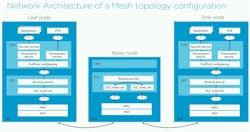Building the Bridge Between Smart Homes and EV Charging
What you'll learn:
- The role of multiprotocol wireless in enabling intelligent energy management in smart homes.
- How combining cellular IoT and local wireless technologies ensures more reliable connectivity.
- The importance of hardware security to protect EV charging infrastructure from emerging threats.
Despite the steady growth of electric vehicles (EVs), charging infrastructure continues to lag behind, making reliable home charging essential.
While installing a charger is straightforward, optimizing its operation for both cost and convenience requires integration with a smart-home ecosystem. However, adding a high-power device like an EV charger to an already crowded home network presents unique connectivity challenges. Engineers must ensure secure, reliable, and scalable communication between chargers, home energy-management systems (HEMS), and other devices.
Advances in wireless connectivity, including Wi-Fi, Bluetooth, Thread, and the Matter standard, as well as alternatives such as cellular and non-cellular IoT technologies, are helping designers overcome the obstacles.
The Necessity of Smart At-Home Charging
As the world's major automakers channel R&D to an all-electric future, the need for intelligent, connected charging is rising, especially due to fluctuating energy costs and increasing demands on the electric grid. Smart-home integration allows users to schedule charging for off-peak hours, monitor charging status remotely, and even redirect excess solar power to the EV. This level of control requires secure and unfailingly reliable wireless connectivity, capable of relaying usage data, system health, and availability to a central platform.
For local user interaction and integration with other smart-home devices, the Matter standard is emerging as the key unifier. By building on top of proven IP-based protocols like Wi-Fi and Thread (with Bluetooth LE for commissioning), Matter aims to bring seamless interoperability to smart homes. In turn, the EV charger can communicate seamlessly with a HEMS or other devices like smart plugs, as well as solar inverters or energy storage, enabling flexible automation. But Matter can’t do it all by itself.
The increasingly close ties between the smart home and the EV are creating a new frontier for innovation. But the solution isn’t a single wireless standard, but a combination of connectivity technologies — each chosen to meet specific performance, range, and reliability requirements.
Combining Cellular and Non-Cellular IoT for Guaranteed Connectivity
While Wi-Fi is the default way to connect many smart-home devices to the cloud, it’s not always the optimal solution for charging infrastructure. Today, EV chargers are often installed in locations with notoriously poor Wi-Fi coverage, such as concrete basements, underground parking facilities, or detached garages far from the home router. In these scenarios, relying on the local Wi-Fi network can be impractical — and unreliable. This is where cellular IoT technologies can come into play.
By embedding LTE-M or NB-IoT connectivity directly into the charger, manufacturers can bypass the local network entirely. It creates a separate, secure, and professionally managed connection to the cloud, guaranteeing uptime regardless of the quality of the Wi-Fi network. This direct-to-cloud approach simplifies installation and provides a robust link for critical functions such as payment processing, over-the-air (OTA) firmware updates, and remote diagnostics.
The connectivity challenge evolves in multi-charger settings, such as apartment complexes, small businesses, or new housing developments. Equipping every charger with its own cellular or Wi-Fi connection could be costly and complex to manage.
In these situations, it can make sense to use mesh networking to connect all of the chargers to each other and a gateway that further connects them to the cloud. One potential solution is DECT NR+, a non-cellular 5G standard. Operating in a dedicated and license-free 1.9-GHz band, it allows you to create private, self-healing, and highly robust mesh network connecting dozens or even hundreds of chargers. This low-latency network is ideal for load balancing and coordinated charging across multiple vehicles.
In a DECT NR+ topology, one — or several — chargers can act as a sink node (or gateway). This sink node is the only unit that requires a backhaul connection to the internet, which is available via cellular IoT, Wi-Fi, or Ethernet. It then relays all data for the entire cluster of chargers, dramatically reducing infrastructure costs and simplifying network management.
The Keys to the Wireless IoT: Security and Connectivity
Bringing all of these wireless protocols into a single device is one of the main challenges for engineers.
For example, a modern connected EV charger may need to support Wi-Fi for its primary connection with cellular IoT as a fallback, DECT NR+ for local networking, and Bluetooth LE for initial setup. Supporting them requires wireless SoCs with multiprotocol radios as well as sufficient processing and memory to run multiple protocol stacks — or wireless modules bundling many of the same building blocks in a more plug-and-play package.
The growing complexity of the wireless IoT has pushed suppliers such as Nordic Semiconductor to develop SoCs that integrate more radios, more processors, and more memory to run multiple wireless protocols at the same time.
Beyond protocol support, one other issue involves implementing robust, hardware-based security. An EV charger isn’t just another smart home gadget; it’s a high-power appliance connected to both the electrical grid and the cloud. The attack surface is significant, and the consequences of a breach are severe. A compromised charger could be used to disrupt the power grid, commit energy theft, expose sensitive user data and billing information, or even create a physical safety hazard.
Securing these devices requires a defense-in-depth strategy anchored in hardware. A software-only approach is insufficient, as it can be circumvented if an attacker gains initial access. The foundation of modern IoT security is a root of trust (RoT). This is an immutable, trusted system within the SoC or the system that serves as the anchor for all security operations. Building upon the RoT, a secure system must provide several key services:
- Secure boot: Every time the device powers on, the RoT verifies the cryptographic signature of the bootloader and application firmware. This ensures that the device only ever runs authentic, untampered-with software, preventing persistent malware infections.
- Secure firmware updates: OTA updates are essential for patching vulnerabilities and adding features. A secure update mechanism ensures that the device cryptographically verifies the authenticity and integrity of a new firmware image before installation, preventing attackers from loading malicious code.
- Secure key storage: The device needs to store cryptographic keys for encrypting communications and authenticating itself. These keys must be protected in a secure vault, isolated in hardware, to prevent them from being extracted even if an attacker has physical access to the device.
- Hardware isolation: Critical processes must be isolated from the main application. Technologies such as Arm TrustZone create a secure processing environment, where cryptographic functions and other sensitive operations can be executed separately from the less-trusted, internet-facing application code.
IoT solutions that are PSA Certified, such as those offered by Nordic Semiconductor, provide the highest level of security assurance. This third-party certification validates not just robust software protection, but also substantial resistance to sophisticated physical hardware attacks, giving designers and end-users confidence that the device's security foundation is sound.
Multi-Protocol Wireless Connectivity Covers All the Bases
By leveraging cellular IoT for guaranteed connectivity, Matter for smart-home interoperability, and DECT NR+ for scalable multi-charger networks, developers can create truly intelligent charging solutions. With advanced multiprotocol SoCs and unified software platforms like the nRF Connect SDK, companies are now equipped to bridge the gap, driving convenience, energy efficiency, and innovation in the future of residential EV charging.
About the Author
Martin Lesund
Technical Product Manager, Nordic Semiconductor
Martin Lesund is a Technical Product Manager at Nordic Semiconductor with experience as a Technical Marketing Manager and Application Engineer. Prior to their current role, Martin served as a Skytter CV90 at Forsvaret - Norwegian Armed Forces. Martin holds a Master's degree in Electronics, Design of digital systems from the Norwegian University of Science and Technology and a Bachelor's degree in Automation Engineering from Western Norway University of Applied Science.



